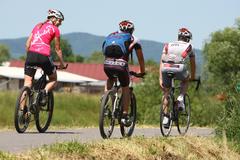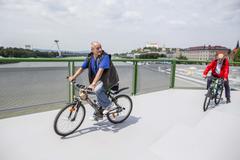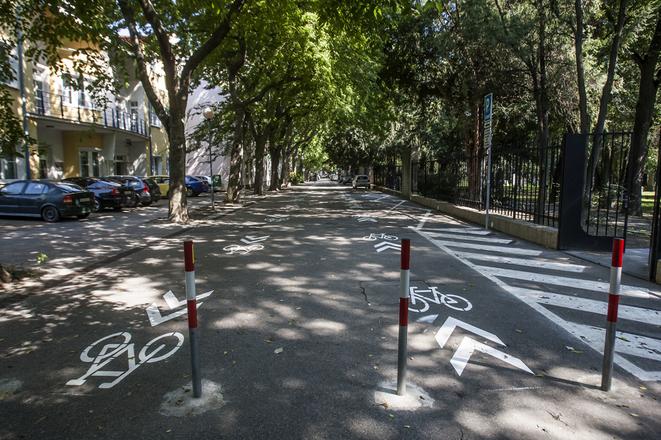The Netherlands and Nordic countries were among the pioneers of the current cycling initiatives in Europe and have developed cycling infrastructure innovations that other European countries could emulate.
While this alternative mode of transport has not always enjoyed such support in Slovakia, general interest in cycling is slowly starting to show. Still, tourists and commuters alike say that there is a lack of cycling routes in Slovakia, according to Igor Trenk of the Cyklokoalícia civic association.
“That is one of the reasons why many cyclists who go along the Danube River on the Petržalka waterside only bypass Bratislava and move forward,” Trenk told The Slovak Spectator.
Support from the EU in the form of the Integrated Regional Operational Programme (IROP) is encouraging a shift towards a low-carbon economy. As part of the IROP process, entities apply for a non-refundable contribution that will help them raise the attractiveness and capacity of motorless transportation, with an emphasis on improving access to cycling.
The Agriculture Ministry said that the first round of applications came mainly from cities, municipalities and their associations and self-governing regions. “The largest proportion of the applicants were from urban areas,” Zuzana Peiger Ačjaková of the communication and marketing department of the Agriculture Ministry told The Slovak Spectator.
In March 2017, the programme topped the second half of its operation period 2014-2020. The programme allocates a total of €24 million for cycling paths and infrastructure, of which applicants have already drawn more than €14 million during the first round. The demand in some regions exceeded the allocations provided, so those areas did not receive the full support they requested, the ministry said.
Using own resources
In addition to EU support, Slovakia’s Transport Ministry has provided nearly €1 million to develop cycling infrastructure for the period of 2014-2017. The call for proposals was announced in December 2016, and the ministry is currently assessing submitted project drafts, according to the Transport Ministry spokesperson Karolína Ducká.
However, authorities expect a strong increase in the construction of routes during the period of 2017-2020 and anticipate a total of €400 million to be spent on regional projects that encourage safe and clean transportation, including cycling, the Sme daily reported.
Bratislava Region also uses the cross-border programmes INTERREG for construction, along with Hungary and Austria, with a total allocation of €85 million, said Lucia Forman, a spokesperson of Bratislava Region. Some of these projects include Sacra Velo, Discover the Small & Moson Danube by Bike and Boat and cycling bridges across the Morava River to Austria.
However, the government did not approve a €2 million proposal from the state budget for cycling infrastructure, which Trenksees as an indication that the Slovak government is not as willing to support cycling initiatives as the governments of the Czech Republic and Austria have been.
City promotes cycling too
Following the European trend of developing cycling programmes in cities, in particular, Bratislava city council has reserved €600,000 for its development in 2017, directed toward the construction of routes on Starohájska Street in Petržalka, Zero Circuit (Nultý okruh) in Staré Mesto and Jarošova Street in Nové Mesto. The city is also focusing on repairing existing routes and settling property rights disputes on Rožňavská, Tomášikova and Alstrova streets and Hodžovo Square, said Katarína Kohútiková, spokesperson of Bratislava city council.
However, Cyklokoalícia sees additional resources coming only from its unrealized routes from 2016. Trenk said that the real budget for routes of €300,000 is the same amount of money allotted for Trnva, a city one-seventh the size of Bratislava.
New routes
Recent support has led to the successful expansion of cycling routes, route markings, and cycling tourism promotion. The latest projects brought cycling routes to Štúrová and Banskobystrická streets, the reconstructed Starý Most (Old Bridge) and the Petržalka district, according to Ducká.
Construction projects have also grown outside of Bratislava. Patrik Velšic, of Trnava Region, noted new routes in Trnava, Galanta, Piešťany, Senica, Skalica, Hlohovec and Dunajská Streda. Trenčín Region has focused on the 100-km long Vážska cycling route along the Váh River and connections of Nemšová with Trenčín and Trenčín’s city centre with the Soblahov district, according to the region’s spokesperson Veronika Rezáková.

Oľga Prekopová, of Nitra Region, pointed to new cycling routes from Nitra to Banská Bystrica Region, asphalt-paved routes near Komárno and Kolárovo and restored routes near Nitra, Zlaté Moravce and Podhájska.
Prešov Region worked with the new coordination center CycloPO in the construction of the Veľký Šariš-Pečovská Nová Ves and Prešov-Muszyna-Mníšek nad Popradom routes, said Daša Jeleňová, of Prešov Region. Eastern Slovakia also offers a portion of the cycling route EuroVelo 11 that is, along with the Dolnozemplínska Route, one of the the main projects within Košice Region, according to the region’s cycling coordinator Adriana Šebešová.
Shared bicycles
Cities might increase interest in cycling through bike-sharing programs. These typically use automated interconnected stands that allow people to rent bikes for a fee and return the bikes to another stand. Bratislava said several years ago that it planned to establish such a system, and in June 2017 the city council introduced the formal plan in collaboration with Slovnaft oil company.
Bratislava mayor Ivo Nesrovnal considers the incorporation of urban bikes into the public transport system a further step toward making Bratislava a modern and ecological city.
“We take cycling transportation seriously, and this project will bring a qualitative shift within this sphere,” Nesrovnal said in a press release.
Slovnaft, of which parent company MOL in the past contributed to a similar project in Budapest, will manage the system and donate a part of the revenues from the system to the city. The pilot phase should start in the Staré Mesto, Petržalka, Nové Mesto and Ružinov districts in early 2018. Bratislava will contribute €460,000 to the project, while Slovnaft will contribute €1.5 million.
National cycling route
Parliamentary Speaker Andrej Danko proposed during a June talk show with the private broadcaster Radio Expres that new legislation on road construction could facilitate the expropriation of land for the construction of cycling routes. “A national cycling route would connect municipalities and cities, meet technological parameters and allow in certain territories to expropriate lands for the spreading of the EU funds to regions,” Danko said on June 7.
Cyklokoalícia, however, said that the idea is inappropriate and lacks a relevant discussion about the consideration of society’s public interest. Today, the authorities dispose with sufficient tools to describe route construction as construction in the public interest, said Peter Netri of Cyklokoalícia, as cited by the Aktuality.sk website.

According to Forman, the construction of new bike routes in Slovakia today encounters several barriers, including property ownership challenges, a lengthy process of public procurement, a permanent lack of resources from the government and limited EU resources.
Despite this, regional officials and the public are more commonly considering cycling to be one of the least expensive and most environmentally-friendly ways to travel within cities and municipalities. Ducká pointed out that people want to be healthier, improve the environment and live economically.
“They do not want to spend hours in the car, waiting in traffic jams and searching for parking spaces,” Ducká said.



 Cycling routes in Bratislava. (source: Sme)
Cycling routes in Bratislava. (source: Sme)